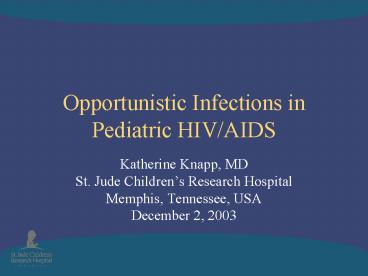Opportunistic Infections in Pediatric HIVAIDS PowerPoint PPT Presentation
1 / 18
Title: Opportunistic Infections in Pediatric HIVAIDS
1
Opportunistic Infections in Pediatric HIV/AIDS
- Katherine Knapp, MD
- St. Jude Childrens Research Hospital
- Memphis, Tennessee, USA
- December 2, 2003
2
1994 Revised CDC Classification for Pediatric HIV
Infection - Immunologic
MMWR, 1994 43 (No. RR-12) p.1-10
3
1994 Revised CDC Classification for Pediatric HIV
Infection - Clinical
MMWR, 1994 43 (No. RR-12) p.1-10
4
N Not Symptomatic
- No signs or symptoms of HIV infection, or
- Only one of the conditions listed in Category A
5
A Mildly Symptomatic(2 or more, none of
Category B or C)
- Lymphadenopathy ( 0.5 cm at gt 2 sites or
bilateral at 1 site) - Hepatomegaly
- Splenomegaly
- Dermatitis
- Parotitis
- Recurrent or persistent upper respiratory
infection, sinusitis or otitis media
6
B Moderately Symptomatic
- Several diagnoses in this category some
examples - Single episode of bacterial meningitis, pneumonia
or sepsis - Thrush persisting gt 2 months in children over 6
months of age - Recurrent or chronic diarrhea
- Recurrent HSV stomatitis (gt 2 episodes within 1
year)
7
B Moderately Symptomatic (continued)
- More examples
- Herpes zoster (shingles) 2 distinct episodes or
gt 1 dermatome - Leiomyosarcoma
- Lymphoid interstitial pneumonia (LIP) or
pulmonary lymphoid hyperplasia (PLH) - Persistent fever (gt 1 month)
- Varicella, disseminated (complicated chickenpox)
8
C Severely Symptomatic
- Some examples
- 2 or more culture-confirmed serious bacterial
infections over a 2 year period - Esophageal or pulmonary candidiasis
- Extrapulmonary cryptococcosis
- Disseminated histoplasmosis or coccidioidomycosis
- Pneumocystis pneumonia
- Progressive multifocal leukoencephalopathy
- Tuberculosis
9
OIs in Children Compared to Adults
- Less common in children
- Cryptococcosis
- Toxoplasmosis
- Cancers, e.g., Kaposis sarcoma
- Different for children
- Primary infection with pneumocystis
- LIP/PLH
- Leiomyosarcomas
10
Pneumocystis Pneumonia (PCP)
- Cause recently identified as Pneumocystis
jiroveci (not P. carinii, as previously thought) - Peak age of onset 3 6 months
- Acute onset fever, tachypnea, rib retractions,
hypoxemia - Chest x-ray normal to bilateral interstitial
and alveolar infiltrates - Higher fatality in infants than in adults
11
Prophylaxis
- Preferred Trimethoprim-sulfamethoxazole
(TMP-SMX) - Alternatives
- Dapsone ( 1month)
- Aerosolized pentamidine ( 5 years)
- Atovaquone
12
PCP Prophylaxis
- Continue for first year of life in all infected
infants - 1-5 years if CD4 count lt 500 or lt 15
- 6 years if CD4 count lt 200 or lt 15
- The safety of discontinuing (primary or
secondary) prophylaxis in children has not been
studied extensively
13
Mycobacterium avium Complex
- Prophylaxis indicated for the following
- lt 12 mos CD4 lt 750
- 1 2 years CD4 lt 500
- 2 6 years CD4 lt 75
- gt 6 years CD4 lt 50
- Clarithromycin or azithromycin
- The safety of discontinuing prophylaxis has not
been studied in children.
14
Recurrent Bacterial Infections
- Immunization
- Antibiotic Prophylaxis?
- IVIG
- In children with hypogammaglobulinemia (IgG lt 400
mg/dL) - Consider for children with recurrent severe
bacterial infections despite daily TMP-SMX or
other antibiotic
15
Secondary Prophylaxis for Life
- PCP
- Toxoplasma encephalitis
- Mycobacterium avium complex disease
- Cryptococcosis
- Disseminated histoplasmosis or coccidioidomycosis
- CMV end-organ disease (e.g., retinitis)
16
Lymphoid Interstitial Pneumonia
- Diffuse lymphocytic infiltrate (PLH is focal)
- May see chest x-ray findings first
- Chronic cough, progressive hypoxemia, clubbing of
the fingers - Associated with EBV
- May respond to steroids
- Tend to be older, less ill appearing than infants
with PCP
17
Leiomyosarcoma
- Smooth muscle tumors specifically associated with
HIV infection in children - Associated with EBV in children with HIV (but not
leiomyosarcomas in non-infected persons)
18
Immunization of the HIV-Infected Child
- All routine childhood immunizations except
live-virus vaccines - MMR may be given if patient not severely
immuncompromised (category 3), may give 2nd dose
4 weeks later - Consider varicella vaccine for class N1 or A1
- Passive immunization measles, tetanus
- Yearly influenza vaccine
- Consider Hepatitis A vaccine
- Also, yearly TB skin test

